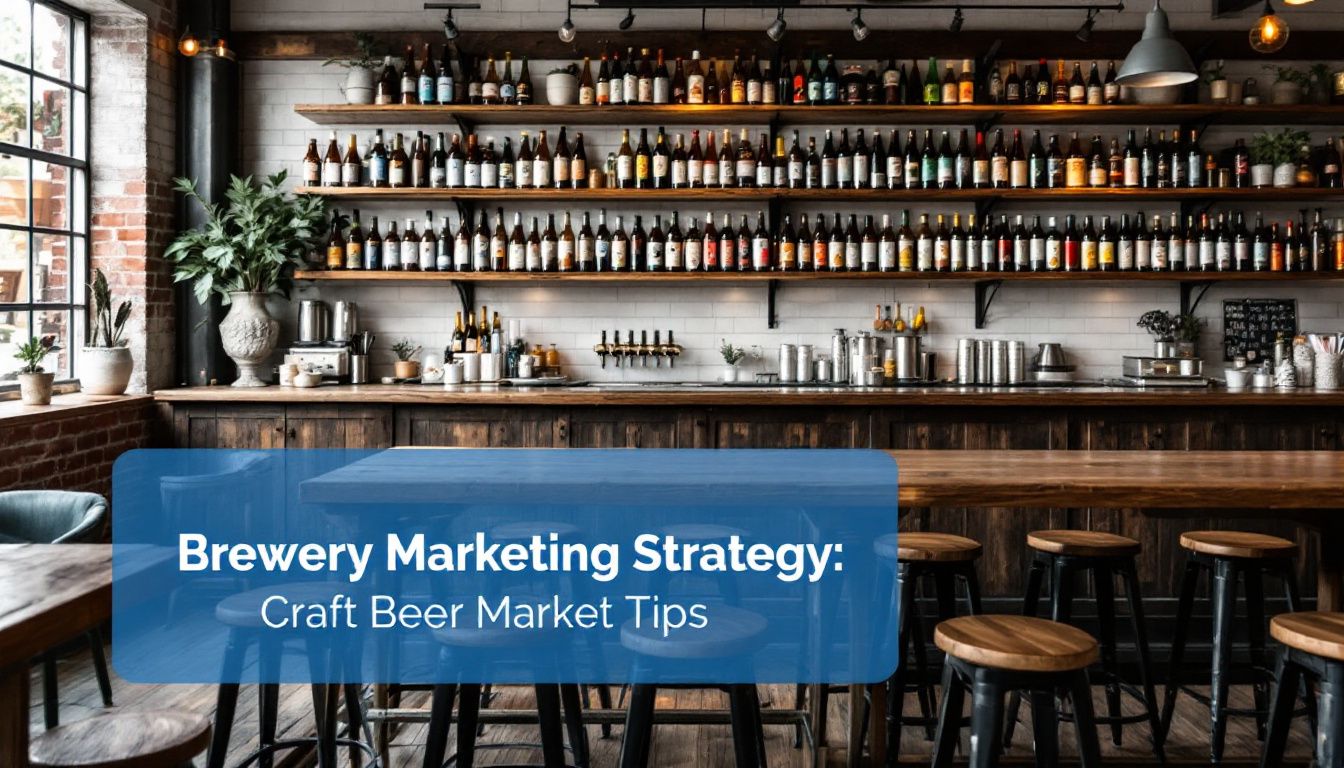Are you having trouble bringing in new customers and getting your brewery noticed? I know it can feel challenging. After doing some research, I found out many breweries spend around 7-8% of their revenue on marketing just to stay visible.
In this post, I’ll share simple tips to boost your craft beer marketing—both online and at local events—to help grow sales without breaking the bank. Keep reading for easy ideas you can start using today.
Key Takeaways
- Top craft breweries typically put 7-8% of revenue into marketing—but new ones might need 12-20% to get noticed early on.
- Loyal customers usually spend 67% more than newcomers, making simple loyalty ideas—like punch cards—a cheap, effective way to increase earnings.
- Teaming up with food trucks can boost brewery sales by about 15%—drawing fresh crowds without big budgets.
- Folks who grab branded merch usually spend around 30% more on beer—and merchandise can yield profits of 40-50% per item sold.
- Keep an eye on marketing results through sales numbers, website traffic, guest interactions, and event turnout—to spot what’s working best.
Defining a Brewery Marketing Strategy

A solid marketing strategy guides your brewery to reach beer fans and boost sales. First step—set clear goals tied to your budget. Most successful craft breweries allocate around 7-8% of their total revenue for marketing.
My approach combines online tools like social media and email lists, with in-person events, tastings, and community meet-ups. Great strategies tell the brewery’s unique story and give visitors memorable experiences.
Those positive interactions help turn casual guests into regulars. Digital platforms help track results easily, showing exactly what’s clicking. Teaming up locally, especially with food trucks or neighborhood businesses, stretches marketing dollars effectively.
Balance is everything—blend branding efforts with direct sales activities that match the brewery’s vibe and core values. Next, let’s break down specifics on setting clear marketing goals.
Setting Goals and Objectives for Craft Beer Marketing
Clear marketing goals are key for your brewery to grow effectively—setting SMART targets makes tracking easier, keeps spending smart, and helps you stay on track.
Here are some practical and specific goals to help make your marketing count:
- Aim for revenue growth around 10–15% every year through marketing alone.
- Dedicate about 7–8% of gross revenue to marketing each year, enough to stay visible without overspending.
- Focus on keeping existing customers—it’s five times cheaper than finding new ones—set clear retention targets.
- Create clear benchmarks for social media engagement—the likes, shares, and comments you aim for each month.
- Set monthly targets for website visits—use simple analytics tools to see your progress.
- Track your email marketing success—set clear open rate and click-through goals to see what’s working.
- Roll out a customer loyalty program—set quarterly membership sign-up targets to gauge success.
- Build local partnerships—aim for 5–10 new relationships with nearby businesses each year.
- Set attendance goals for brewery tours and events—figure out how many people you want coming through.
- Track your brewery’s brand awareness—clearly measure how many people recognize your name and logo.
- Promote user-generated content—set goals for how much customer-created stuff you’d like to see online.
- Aim for specific numbers of positive customer reviews on Google, Yelp, and similar platforms.
Next up, let’s sort out how you’ll budget your marketing so these targets become a reality.
Budgeting for Brewery Marketing
I set aside 5-8% of my yearly sales for my brewery marketing budget – this cash helps me grow my brand while still keeping my beer prices fair… read on to see how I break down these costs across digital ads, events, and merch that actually work!
Percentage of Revenue
I usually invest around 7–8% of my brewery’s total revenue into marketing—that keeps us visible in today’s crowded craft beer scene. This amount helps me hold on to current customers and keeps our brand fresh in people’s minds.
If I’m aiming for quicker growth or launching new beers, marketing spending jumps up to 10–20%. For new breweries, costs are often even higher—first-year breweries regularly spend extra to stand out from the competition.
The best budget level really depends on your own goals, plus the local brewing market. Industry benchmarks can help you figure out if you’re spending enough—or maybe a little too much—compared to similar craft beer businesses.
Industry Benchmarks
The percentages we just covered offer a starting point, but knowing what other breweries spend gives you better context for your own budget decisions. I’ve gathered industry benchmarks based on my experience working with dozens of craft breweries across the country.
| Brewery Type | Marketing Budget (% of Revenue) | Notes |
|---|---|---|
| New/Start-up Breweries | 12-20% | Higher initial investment needed to build brand awareness |
| Established Breweries | 8-12% | Focus on maintaining market presence |
| Growth-Phase Breweries | 10-20% | Aimed at expanding market share |
| Standard Market Visibility | 7-8% | Baseline for staying competitive |
Most craft breweries find success with a mixed approach to marketing spend. During my first year running a small brewery in Colorado, the 15% marketing budget seemed steep – but the return became clear as taproom visits increased 40% within six months. Email campaigns proved especially effective, matching the industry average of $36 return for each dollar spent. The numbers vary based on location, competition, and growth goals. Regional breweries tend toward the lower end of these ranges once established, while urban breweries face higher costs due to competitive markets.
Top Craft Beer Marketing Strategies
I’ll show you the best craft beer marketing tricks that work for breweries of all sizes – from social media to local events – so keep reading to learn how to get more fans through your doors!
Build a Strong Online Presence
A great brewery website grabs attention right away—especially from beer fans. It has to look sharp and work smoothly on phones, since that’s how most folks search now. People get curious about what beers you offer, what’s new, and the story behind your brewery.
The taproom hours need to stand out too—it’s easier for visitors to drop by.
Clear, appealing photos matter a lot. Good pictures make people crave your beers and want to taste them. Your site should load fast, feel simple, and avoid frustration. Quick page loads keep visitors around longer.
A short, casual blog helps you stay in touch with visitors. Share quick updates on brewing styles, special batches, or upcoming events. Visitors like checking back for new stuff and becoming regulars on your website.
Also, social media buttons make sharing quick and help spread your brand.
Small breweries generally do well putting 7-8% of their overall budget into marketing. It might seem like a lot, but it really boosts business. A solid, simple website connects you to local beer drinkers and tourists looking for a good pint.
Master Local SEO and Business Listings
I want people to find my brewery easily in local searches and maps. Google Business Profile is my first step—I add clear photos, accurate open hours, and an updated beer menu. My name, address, and phone number (the business NAP) stays consistent everywhere—on Yelp, TripAdvisor, and popular beer apps.
Doing local SEO right helps customers walk in without spending tons on ads.
My brewery pops up quickly in searches like “craft beer near me”, because my site pages use local keywords. Each page says my city’s name, plus terms customers might use, like “IPA” or “brewery tours”.
Customer reviews really count—good feedback online pushes me up in local rankings. Simple methods like these beat complicated marketing ideas every time.
Develop a Customer Loyalty Program
Once your local SEO is solid, a loyalty program can help turn casual visitors into loyal regulars. At my brewery, we keep things simple—a punch card that offers one free pint after ten visits.
It might sound basic, but this approach seriously boosts profits. For example, based on my sales data, loyal customers spend about 67% more than new guests.
We also add personal touches, like birthday rewards, early tastings for new beers, and private events just for members. These small perks go a long way… customers feel valued and part of our beer-loving community.
Even better, my team knows many regulars by name—giving our spot a friendly, hometown atmosphere that craft beer fans love. You don’t really need fancy tech to run a great loyalty program.
All it takes is genuine care and attention for the people who regularly support your brewery.
Leverage Social Media and User-Generated Content
Now that I have a solid loyalty program in place, social media is the next step. Craft beer fans enjoy sharing their latest finds online—perfect for my brewery. Simple, regular posts about new beer launches, brewing tips, and behind-the-scenes moments can keep beer lovers engaged.
It boosts brand awareness, too, without spending big.
User-generated content is marketing gold. Happy customers posting pictures with my beers can draw more attention than paid ads ever could. I connect with local restaurants and social media influencers, making it easier for new customers to find me.
Stories about the brewery’s start and special beer flavors give people content they actually enjoy sharing. Keeping an eye on likes, shares, and comments shows me exactly which posts resonate most.
Host Strategic Events and Brewery Tours
Social media definitely spreads the word—but real connections happen face-to-face. Hosting events and tours builds stronger bonds, turning casual guests into loyal brewery fans. Here’s what works, from my experience:
- Trivia nights draw different crowds—even on slow weekdays. They turn the taproom into a lively community spot and increase beer sales.
- Seasonal festivals aligned with fresh beer launches excite visitors and encourage repeat visits all year.
- Brewery tours invite guests behind the scenes, connecting them personally to how we craft our beer.
- Offering small samples during brewery tours keeps visitors engaged, having fun, and often buying more beer to take home.
- Food truck partnerships attract hungry guests to linger longer, boosting drink sales through tasty food pairings.
- Partnering with local businesses to host fun events—like “Yoga and Beer” or “Paint and Sip”—brings in fresh groups of customers.
- Selling event tickets online helps me track attendance and collect emails for future promotions.
- Selling quality brewery merch at events turns satisfied visitors into brand ambassadors who advertise my brewery everywhere they go.
- Sharing authentic stories during tours builds personal connections, creating deeper emotional bonds than any single beer tasting could.
- Tracking event data clearly reveals which events deliver the biggest returns on my marketing dollars.
- Exclusive limited-capacity events—like brewer-hosted dinners—spark FOMO and make my brand feel special.
- Dog-friendly celebrations encourage visitors with pets to hang out longer, sharing lots of brewery moments on social media.
Partner with Local Businesses and Food Trucks
Partnering with local shops and food trucks really boosted my brewery’s business. Last month, sales jumped by 15% just from hosting a weekend food truck fest—people poured in from all over town.
These team-ups are win-win. Food trucks gain hungry customers, and my taproom gets packed with folks ready for beer and good eats. Local partnerships also draw in new faces who otherwise might not drop by a brewery.
Food truck nights have quickly become my best marketing move—they offer amazing returns on investment. The pizza truck parked outside every Friday brings double the usual crowd. I also trade deals with local restaurants.
They pour my craft beer, and I point brewery visitors over to grab food after tours. This builds a tight-knit community vibe, boosting brand loyalty way better than traditional ads could.
Craft beer thrives on these kinds of local connections.
Invest in Quality Branded Merchandise
Quality branded merch turns my regulars into walking billboards for my brewery. Beer glasses, t-shirts, bottle openers—they all create a unique vibe customers love sharing on social media.
Good merch isn’t just fun; it makes money and builds loyalty too. At my brewery’s last event, people who grabbed merchandise also spent about 30% more on beer. So yeah, even without me there, quality merch keeps doing the heavy lifting.
Branded gear does double duty: it sells more beer and boosts marketing reach at the same time. Good merch reflects my brewery’s personality, our special process, and our whole style.
Customers actually post selfies online wearing our hats and hoodies—that gets us noticed, without costing extra. Locals sport our shirts around town, creating buzz that regular ads can’t touch.
Plus, the profit margins on solid merchandise—think 40-50%—make it a smart move for my tight marketing budget.
Measuring the Success of Your Marketing Strategies
You need to track results to know if your marketing works. Numbers don’t lie – they show you what’s working and what needs to change.
Sales Data and Revenue Growth
I track my brewery’s success through numbers that tell the real story. Sales figures and growth rates reveal if my marketing efforts are working. Let me share how I measure these vital signs in my craft beer business.
| Revenue Metric | What to Track | Why It Matters |
|---|---|---|
| Monthly Sales Growth | Month-over-month percentage increase | Shows immediate impact of marketing campaigns |
| Per-Product Performance | Sales volume by beer type | Reveals which products deserve more marketing focus |
| Marketing ROI | Revenue generated per marketing dollar | Craft breweries should spend 7-8% of gross revenue on marketing |
| Customer Loyalty Impact | Repeat purchase rate | Loyalty programs boost revenue through regular customers |
| Event-Driven Sales | Revenue spikes after hosted events | Strategic events create measurable sales growth |
| Email Campaign Results | Direct sales from email promotions | Email marketing delivers strong return on investment |
Data analysis forms the backbone of smart marketing choices. The numbers never lie – they show exactly which strategies bring in money and which fall flat. Many breweries miss growth chances by ignoring these metrics.
Customer Engagement and Feedback
Sales numbers matter, but customer engagement shows how well your brewery connects with people.
- I watch social media closely—Instagram likes, comments, and shares quickly tell me which beers get customers excited.
- Google and Yelp reviews give clear customer opinions on the brewery—93% of new craft beer drinkers check online reviews first, making these vital for growth.
- Email surveys let customers easily share opinions—highlighting what they love most and where I could do better.
- Event attendance tracking reveals which brewery activities draw the best crowds—popular events then become regular calendar items.
- My loyalty program data spotlights frequent visitors and their favorite beer selections—helping me create special offers these top fans appreciate most.
- Face-to-face conversations during brewery tours provide honest, direct feedback—often inspiring fresh beer concepts or taproom upgrades.
- My website analytics show popular pages and how long visitors stay—guiding me to make my brewery website easier to use.
- I reply quickly to social media messages and comments—fast answers show visitors their opinions and questions genuinely matter.
- Taproom feedback cards encourage quieter visitors to speak up—revealing smaller issues I might otherwise overlook.
- I monitor brewery brand mentions across websites using Google Alerts—this helps me understand how far the brewery’s reputation spreads online.
Website Traffic and Analytics
I use my website stats to understand my craft beer fans better—who they are, what they enjoy, and how to boost my brewery business.
- Google Analytics shows which beer pages get visited the most.
- Average visit duration tells me which beers keep people interested longer.
- Bounce rates indicate whether visitors quickly leave or stick around.
- Mobile visits matter, since most people now browse from their phones.
- Quick-loading pages keep more visitors on my site.
- Traffic sources explain if visits come from social media, search engines, or other websites.
- Conversion tracking shows if visitors actually buy beer or register for brewery events.
- Heat maps highlight the places people click most on brewery pages.
- Exit pages identify spots where potential customers decide to leave.
- Search keywords tell me exactly what beer info visitors hope to find.
- Visitor location data helps target local beer lovers near my brewery.
- User paths reveal how visitors move through the site from page to page.
- Email click rates clearly show which brewery news grabs people’s attention.
- Social media tracking measures which platforms send me the most visitors.
- Form completions confirm how many visitors sign up for tours at my brewery.
Now, let’s see how customer feedback combines with these numbers for a complete marketing picture.
Event Attendance and Participation
I keep track of attendance at my brewery events—it helps me know if my marketing actually works. Crowd numbers clearly show what interests customers and guide future planning. Here’s how it works:
- Keeping count tells me which events really pull in customers—trivia nights often fill the seats, while beer launches draw in dedicated beer enthusiasts.
- Noticing regular visitors helps me spot loyal fans—these are the people worth rewarding through our loyalty program.
- Food truck festivals noticeably boost our crowd size and sales, clearly showing that partnering up is great for business.
- Event planning software lets me easily track attendance over months—making seasonal highs and lows obvious.
- Social media check-ins at events tell me who’s engaging in real-time, and they spread the word about our beer naturally.
- Quick customer surveys afterward show exactly what’s working in brewing methods and event design—and what isn’t hitting the mark.
- Monitoring sales jumps during or after events pinpoints exactly which marketing moves turn into real profit.
- Snapping pictures and short videos at busy events gives me plenty of engaging content for newsletters and social posts.
- Games, contests, and fun activities during events boost involvement and create memorable experiences folks want to repeat.
- Telling fun brewery stories at each event helps customers feel closely connected to who we are and what we love about craft beer.
Conclusion
Great craft beer deserves great marketing—you’ve got to stand out in a busy market. Your brewery has its own story, so share it online, through cool events, or tie-ups with local stores.
Spend wisely by tracking sales numbers and listening to what customers actually say. Even tiny breweries can get noticed, with clever content and strong social media buzz. Know your fans, stick to your brand style, and put heart into marketing—just like brewing your beer.







